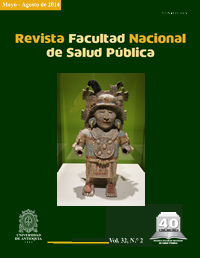Ser niño en situación de calle: un riesgo permanente
DOI:
https://doi.org/10.17533/udea.rfnsp.17168Palavras-chave:
grupos vulnerables, riesgo, factores de riesgo, niños en situación de calle, calleResumo
Downloads
Referências
(1). Forselledo AG. Niñez en situación de Calle. Un modelo de pre-vención de las farmacodependencias basado en los derechos hu-manos. Uruguay: Boletín del Instituto Interamericano del Niño. [Internet]. 2001; 23:64-65. [Acceso 28 de abril de 2011]. Disponi-ble en: http://www.iin.oea.org/forse.pdf
(2). De Venanzi A, Hobaica G. Niños de la calle. ¿Una Clase Social? Trabajo y Sociedad. Indagaciones sobre el empleo, la cultura y las prácticas políticas en sociedades segmentadas. [Internet]. 2003. [Acceso 2 de mayo de 2011]. Disponible en: http://www.unse.edu.ar/trabajoysociedad/DeVenanzi.htm
(3). Domínguez M, Romero M, Paul G. Los “Niños Callejeros”. Una visión de sí mismos vinculada al uso de las drogas. Rev. Salud Mental 2000; 23(3): p 21-22.
(4). Hidalgo P. Los niños de la calle en Managua. Marginación y su-pervivencia en el espacio urbano. Rev. Anales de Geografía de la Universidad Complutense 2000; 25: p 73-92.
(5). Akman M, Arcusin J, Pignata N, Pojomovsky J, Riterman F, Tri-ñares G, et al. Modalidades de abordaje médico a chicos de la calles en hospitales públicos de la Ciudad de Buenos Aires. Arch. argent. pediatr 1999; 97 (4): p 241-48.
(6). Sánchez A. Menores en situación de calle: la doble vulnerabilidad hacia el consumo de drogas. Revista Española de Drogodepen-dencias 2003; 28, (1-2).
(7). Giraldo A, Forero C, López L, Tabares L, Duran P. Encontrar una familia en la calle. Medellín, Rev. Facultad Nacional de Salud Pu-blica 2006; 24 (1): 92-97.
(8). Mejía Navarrete J. Sobre la Investigación Cualitativa. Nuevos Conceptos y Campos de Desarrollo. [Internet]. [Acceso 7 de mayo de 2011]. Disponible en: http://es.scribd.com/doc/2388276/investigacion-cualitativa
(9). Álvarez-Gayou. ¿Cómo hacer investigación cualitativa? Fundamen-tos y metodología. México: Paidos Iberica Ediciones S A, 2003.
(10). Geertz C. La Interpretación de las Culturas. Barcelona: Gedisa S.A; 2003
(11). Taylor S. J. Y Bogdan R. Introducción a los métodos cualitativos de investigación. Barcelona: Piados; 1994.
(12). Sampieri R, Fernández C, Baptista P. Metodología de la investiga-ción. 5ª ed. McGraw Hill; 2010.
(13). Castillo E., Vásquez ML. El rigor metodológico en la investiga-ción cualitativa. Revista Colombia Médica [revista en Internet] 2003; 34:164-167 [Acceso 12 de mayo de 2011]. Disponible en: http://www.bioline.org.br/request?rc03025.
(14). Colombia. Ministerio de Salud. Resolución 8430 de 1993, octubre 4, por la cual se establecen las normas científicas, técnicas y admi-nistrativas para la investigación en salud. Bogotá: Ministerio; 1993.
(15). Red de trabajo con personas en situación de calle (Internet). (Con-sultado 2011 Octubre 25). Disponible en: http://www.redcalle.cl/define_psc.asp
(16). Centros penitenciarios de régimen ordinario [Internet]. [Acceso 25 de octubre de 2011]. Disponible en: http://www.institucionpe-nitenciaria.es/web/portal/centrosPenitenciarios/centrosRegime-nOrdinario.html
(17). Colombia. Instituto Colombiano de Bienestar Familiar (ICBF) [Internet]. [18 de octubre de 2011]. Disponible en: https://www.icbf.gov.co/icbf/directorio/portel/libreria/php/03.0701.html
(18). Organización de las Naciones Unidas. Declaración Universal de los Derechos Humanos [Internet]. [Acceso 18 de octubre de 2011]. Disponible en: http://www.un.org/es/documents/udhr/
(19). Giraldo A, Forero C, López LM, Tabares L, Durán PA. Encontrar una familia en la calle. Rev. Facultad Nacional de Salud Pública 2006; 24 (1).
(20). Convivir eran fachada del paramilitarismo en Urabá. Verdad abierta (Internet). [Acceso 18 de octubre de 2011]. Disponible en: http://www.verdadabierta.com/la-historia/3216-convivir-fachada-del-paramilitarismo-en-uraba.
(21). Organización Panamericana de la Salud. Manual Sobre el Enfo-que de Riesgo en la Atención Materno Infantil. 2da edición. Wash-ington: OPS; 1999. p. 17-18.
(22). Giraldo A, Forero C, Sánchez D y Castaño N. Significados de las instituciones de apoyo para los niños en situación de calle Mede-llín Colombia. Index de enfermería [revista en Internet] 2012 Dic [Acceso 15 de octubre de 2011] 21(4): 204-208. Disponible en: DOI: https://doi.org/10.4321/S1132-12962012000300006
http://scielo.isciii.es/scielo.php?script=sci_arttext&pid=S1132-12962012000300006&lng=es
(23). Rodríguez T, Rodríguez N, Perozo D. Concepto y caracteriza-ción de la problemática de los niños, niñas y adolescentes en condición de calle. Cap. Criminol. [Internet] 2007; 35, no.2:215-250. [Acceso 19 de noviembre de 2012]. Disponible en: http://www2.scielo.org.ve/scielo.php?script=sci_arttext&pid=S0798-95982007000200004&lng=es&nrm=is.
(24). Alor H. Proyecto “Amigos de los niños de la calle”, Perú. [Inter-net]. [Acceso 22 de julio de 2012]. Disponible en: http://unesdoc.unesco.org/images/0011/001175/117547s.pdf
(25). Observatorio argentino de drogas. Estudio sobre consumo de sus-tancias psicoactivas en niñas, niños y adolescentes en situación de calle [Internet]. [Acceso 16 de septiembre de 2011]. Disponible en: http://www.observatorio.gov.ar/investigaciones/La_proble-matica_del_consumo_de_sustancias_psicoactivas_en%20ni.pdf.
(26). Giraldo A, Forero C, Hurtado MA, Ochoa JA, Suarez L, Valencia A. Un viaje que puede controlarse: consumo de drogas en niños en situación de calle. Rev. Fac. Nac. Salud Pública. 2008; 26 (1): 11- 17
Downloads
Publicado
Como Citar
Edição
Seção
Licença
Copyright (c) 2021 Janeth Valencia B., Julia Sánchez C., Leidy C. Montoya T., Álvaro Giraldo P., Constanza Forero P.

Este trabalho está licenciado sob uma licença Creative Commons Attribution-NonCommercial-ShareAlike 4.0 International License.
El autor o los autores conserva(n) los derechos morales y cede(n) los derechos patrimoniales que corresponderán a la Universidad de Antioquia, para publicarlo, distribuir copias electrónicas, incluirlas en servicios de indización, directorios o bases de datos nacionales e internacionales en Acceso Abierto, bajo la licencia Creative Commons Atribución-No Comercial-Compartir Igual 4.0 Internacional Comercial (CC BY-NC-SA) la cual permite a otros distribuir, remezclar, retocar y crear a partir de la obra de modo no comercial, siempre y cuando se dé crédito respectivo y licencien las nuevas creaciones bajo las mismas condiciones.












 --
-- --
-- --
--